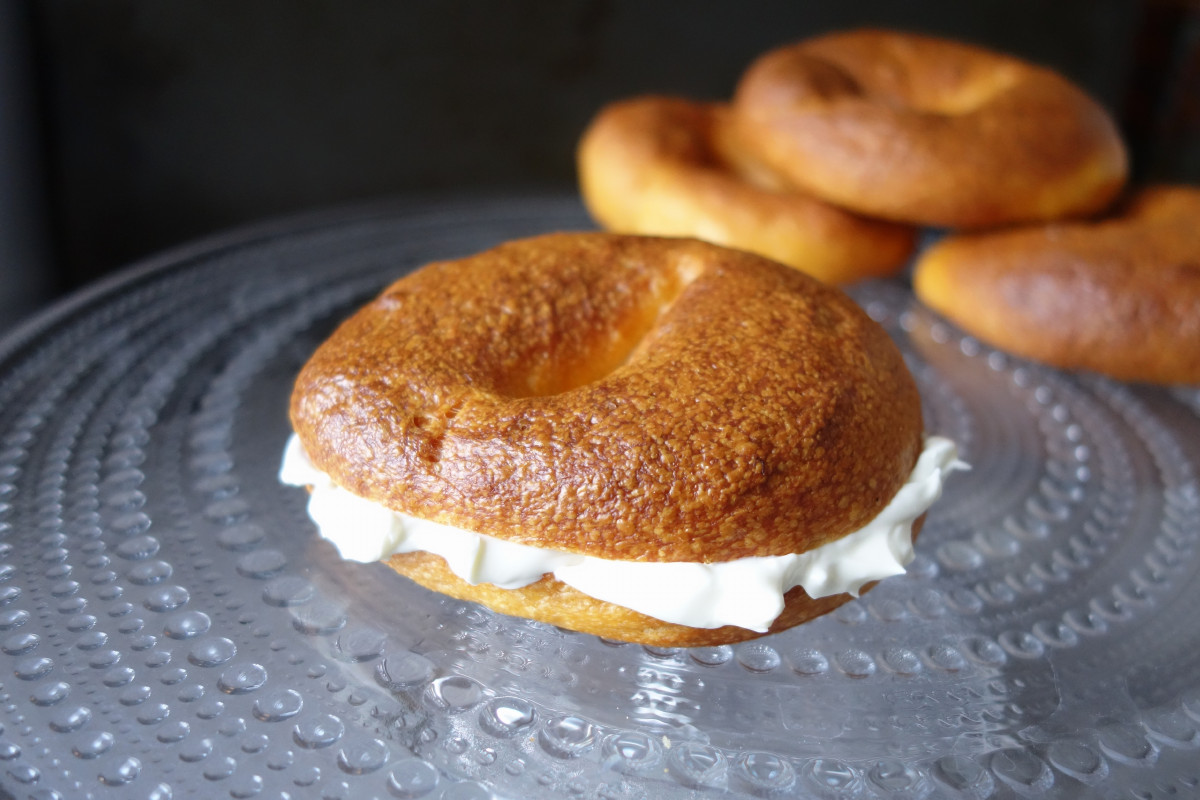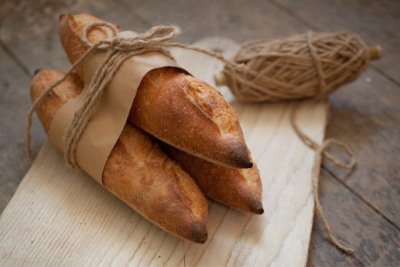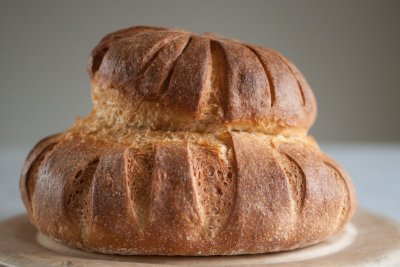Sustain / Real Bread Campaign / Recipes
Roasted carrot bagels
It’s a lockdown thing
In April 2020, I did a survey to find out what people would like me to try using in recipes to partially replace their rapidly-diminishing stores of bread flour. Chickpea bread won but carrots weren’t far behind.
I decided to make carrot bagels as they are favourites of an animated rabbit that my preschool anklebiter loves. Roasting the carrots concentrates the sugars they contain, providing the sweetness created in many bagel recipes by adding sugar or some sort of syrup. It's also a good way of using up a couple of lonely carrots that are going limp in your fridge or veg box.
This recipe was published in April 2020 as part of the Real Bread Campaign's #LockdownLoafers initiative.
Read more about bagels/beigels in this article from the True Loaf magazine archive.
Ingredients
Makes six bagels
170-200g Carrot (peeled, topped, tailed and cut into chunks)
40-100g Water
5g Fresh (or 2g / rounded ½ tsp fast acting*) yeast
4g Salt (1tsp is about 6g)
360g White strong/bread flour
*Read the label and avoid those that contain any additives.
Method
Roast the carrots when using the oven for something else (please don’t turn it on just to do this) with 1-2tsp of oil in a very hot oven for 5-10 minutes until they brown, and even caramelize, on the underside. Alternatively, sauté in a frying pan. Allow to cool and they’ll keep in the fridge for at least a week, or in the freezer for months.
Blitz 130g of the roasted carrot (which is about what they’ll weigh after roasting) with the rest of the ingredients, except the flour, to a liquid using a stick or jug blender or a food processor. See tips below for a note on the water.
Mix in the flour and work until you have a stiff, smooth and stretchy dough. As this dough is tight, you might find it easier to do in stages, covering the dough and leaving it to rest for ten minutes to allow the gluten to relax between each bout.
Cover the bowl (eg with a carrier bag that you can reuse again and again) and leave to rest for half an hour or so.
Leave the dough at room temperature to prove/rise. Depending on what temperature your room is (mine was about 20-21°C when I created this recipe) for one to two hours.
Lightly dust a work surface with flour, scoop the dough out of the bowl. Degas the dough with your fingers or rolling pin to get rid of any large air pockets, then divide and scale into six equal pieces (they’ll be about 90-100g each) and pre-shape into balls. To make each into a bagel shape, you can either poke a hole in the middle of the ball and ease it open, or roll out to a sausage shape about 10cm long, curl round into a ring, overlap the ends, put two fingers through the hole and roll the dough to seal the join. Search online to disappear down a rabbit hole of bagel-shaping videos…
Oil a baking tray and evenly space the dough rings on it, leaving a few centimetres between each. Cover the dough (I used an overturned roasting tray, but you could use a large bag or sealable box) and put in the fridge for a retarded proof of eight hours or more. You can leave them overnight, if you want.
Heat the oven to 250°C with a baking/pizza stone or heavy baking tray in place. See below for a note on steam. In a large pan, bring water, a few centimetres deep, to the boil. Slide two or three of the dough rings into the water and turn them over with a slotted spatula after 10-15 seconds. Remove from the water and place on a wire rack to dry off. Don’t worry if they’ve collapsed a little – oven spring will puff them back up as they bake.
Place the rings on the stone or tray and bake for 12-15 minutes until browned and cooked through.
Remove the bagels to a wire rack and leave to cool before slicing – they can be gummy if you cut when hot.
Baker’s tips
Bagels are often made using very strong (eg 14% protein) white flour and low hydration (sometimes as little as a baker’s percentage of 50-55% water) resulting in a characteristic chewy texture. Using less strong (eg 11-12% protein) flour and/or more water will give you softer, less chewy bagels, which some people prefer. How much of the water suggested in this recipe you use is up to you.
You could just boil the carrots, but this won’t concentrate the sweetness and, as they won’t lose moisture, means you won’t need to add as much water to reach your preferred dough stiffness.
The stretch and fold method isn’t appropriate for bagels as you are trying to avoid incorporating big air bubbles into the dough.
Professional bagel/beigel bakers tend to use ovens that add steam during the first minutes of baking. This contributes to the glossy, soft and chewy crust. One way to approximate this is to enclose your dough rings for the about the first five minutes of baking, which will trap moisture as it evaporates from the dough and turns to steam, then removing the cover for the remainder of the baking time.
Options of what to use (place in the oven as you’re heating it up) include a lidded casserole, dutch oven or crock pot; and a roasting tray or heatproof dish that will sit on top of your baking stone or tray. The bagels pictured above were actually baked, uncovered, in a fan oven.
Substitutions
In answer any ‘can I…’ questions about swapping or adding ingredients, adjusting times, weights and temperature, the answer is yes, you can. Every tweak you make leads to different results. Seek out those different recipes or experiment for yourself and, if you come up with a bread you love, please share it and your tips on social media!
Recipe © Chris Young / www.realbreadcampaign.org
Reproduction prohibited without written permission of the copyright holder.
Social sharing
If you make this, please share your photo(s) with the world on social media using #RealBread and other relevant hashtags, linking back to this recipe. Better still if we can see you in the photo, too: #WeAreRealBread!
Please don't forget to tag us, and the recipe's author. You can find us on:
- Twitter: @RealBread
- Instagram: @RealBreadCampaign
- Facebook: @RealBreadCampaign
Published Monday 11 May 2020
Real Bread Campaign: The Real Bread Campaign finds and shares ways to make bread better for us, better for our communities and better for the planet. Whether your interest is local food, community-focussed small enterprises, honest labelling, therapeutic baking, or simply tasty toast, everyone is invited to become a Campaign supporter.





